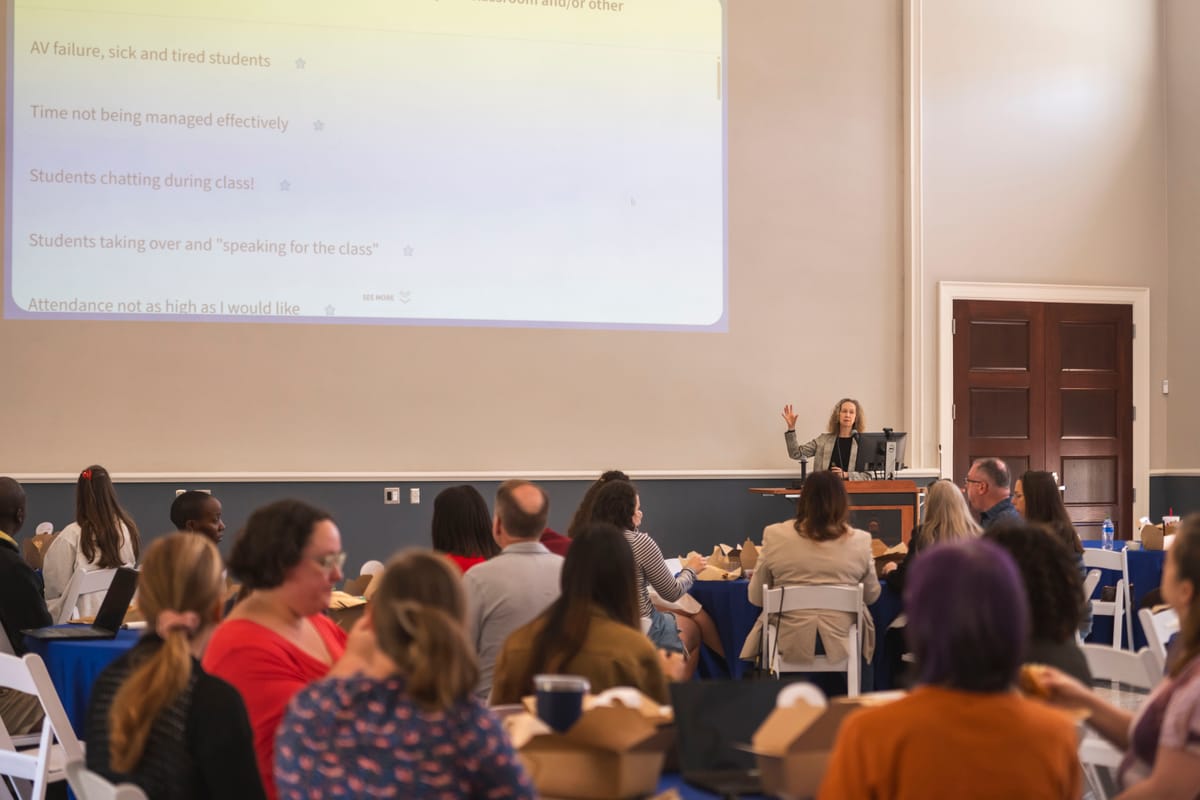Recap: Real Talk about Teaching, with guest speaker Dr. Jessamyn Neuhaus

On Wednesday, October 22, CETL was thrilled to welcome our colleague Dr. Jessamyn Neuhaus to campus. Dr. Neuhaus is Director of the Center for Teaching and Learning Excellence (CTLE) and Professor in the School of Education at Syracuse University. We at CETL know her best for her refreshingly honest books on teaching. Her first, Geeky Pedagogy, is an evidence-based teaching guide for (and love letter to) “introverts, intellectuals, and nerds.” Her second, an edited collection entitled Picture a Professor, shares teaching strategies and reflections for educators who challenge stereotypes about “what a professor looks like.”
Her talk at the University of Mississippi, however, was based on her most recent book Snafu Edu: Teaching and Learning When Things Go Wrong in the College Classroom. (You can find the slides for the talk here.) It had three goals: to give listeners a “reality check” about some of the complexities of teaching and learning; to identify some systemic obstacles that prevent us from recognizing those realities; and to strategize about how we can be more proactive in normalizing teaching challenges.
Dr. Neuhaus began by asking attendees to anonymously share some things that have been going wrong in their classrooms recently. Here at the midpoint of the semester, many people noted that they were struggling with dropping rates of student attendance. Others identified issues with student motivation and engagement, or the problem of students outsourcing their work to artificial intelligence.
It was clear from the poll that most of us are facing similar challenges and importantly, as Dr. Neuhaus pointed out, such challenges are “situation normal” for teaching and learning. Evidence-based teaching strategies, like the ones we discuss in CETL workshops, can help, but it’s unreasonable to expect that these strategies will totally eliminate snafus in the classroom.
Dr. Neuhaus identified five main factors that can negatively impact our experiences, and our students’ experiences, in the classroom: inequity, disconnection, distrust, failure, and fear. Out of these factors came a series of reality checks:
- Humans mess up. Dr. Neuhaus emphasized that teaching, like many pursuits, is not perfectible. We can expect ourselves and our students to make mistakes.
- People have disparate experiences in higher ed. Teachers and students have to navigate a world in which bias, stereotypes, and systemic inequities are a reality. We can expect these realities to affect each of us in different ways.
- Learning is hard. Dr. Neuhaus observed that we’re quick to acknowledge this reality in thinking about our students but less likely to apply it to ourselves. Learning how to teach effectively is difficult work. And no matter how long we’ve been teaching, we’re still learning how to do it as our students, our subjects, and our world continue to change.
- The Super Teacher is a myth. Depictions of college professors in popular media—wearers of tweed jackets who captivate students with their brilliant, and brilliantly-delivered, lectures—are inaccurate and damaging. Such depictions perpetuate wrong-headed notions about how teaching works and contribute to stereotypes that undermine student learning, and our own self-efficacy, in our classrooms.
These are four realities, Dr. Neuhaus argued, that lead to snafus in the classroom. The fact that they are underrecognized in much advice about college teaching can make it harder to identify, repair, and learn from our teaching mistakes. But it is crucial to our thriving that we normalize such mistakes.
There are lots of systemic obstacles to this normalization. For one thing, we all have “disparate teaching realities,” a phrase coined by Roxanna Harlow to describe the many different, often inequitable, teaching contexts faculty encounter. These contexts mean that we’re all doing different kinds of teaching/emotional labor and that publicly acknowledging mistakes carries more risks for some than for others.
A second obstacle is unclear evaluation practices. There is no simple and agreed-upon definition of “good teaching,” and the way faculty are evaluated for it varies widely from context to context. Much assessment of teaching—particularly if it relies on a blurry definition of good teaching or a single, problematic source of information (such as anonymous student evaluations)—is inequitable.
Additionally, we have so few opportunities to recharge our teaching batteries. There aren’t many incentives for engaging in teaching development activities, and moreover, there’s little time to do it. Overloaded faculty don’t get sufficient credit for attempts to improve their teaching, leading to exhaustion and burnout. Relatedly, we face the problem of a closed door teaching culture, meaning we don’t have many opportunities to engage with colleagues about teaching and discuss our shared teaching challenges.
Finally, we’re hampered by a culture of rampant perfectionism in higher ed. We, and our institutions, often expect ourselves to be super teachers when teaching is, again, not a perfectible activity.
So, what can we do to normalize teaching snafus, despite these systemic obstacles? Dr. Neuhaus suggested four strategies:
- Document teaching success. Our successes, even little ones, are important. We should make an effort to track them, using many kinds of evidence to demonstrate the effectiveness of our teaching.
- Get and give better feedback. This includes getting regular feedback from students (beyond the end-of-semester evaluations they submit at a time when no one is at their best) and working with our departments to put better peer feedback mechanisms in place.
- Prioritize pedagogical learning. We should think of our teaching as an ongoing intellectual activity, a process of experimentation, assessment, reflection, and—yes—learning from mistakes.
- Fight the Super Teacher myth. We should push back anywhere we can on gendered and racialized stereotypes about what good teaching looks like. In place of these damaging stereotypes, we can share evidence-based reality checks about the wide variety of ways that professors teach and students learn.
Dr. Neuhaus’s parting advice to attendees was simply to talk more about teaching. She argued that just making time for these conversations with colleagues is one of the most effective ways to normalize setbacks—and to empower ourselves and others in the classroom.
We were delighted to have Dr. Neuhaus on campus for a few days, and we’re excited to be reading her book, Snafu Edu: Teaching and Learning When Things Go Wrong in the College Classroom for our Faculty Reading Group next semester. Stay tuned for more information about that offering in January.




